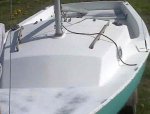Re: how do you rig a spinnnager
The pullies are there so that you can thread the halyards (main and foresail) back to the cockpit of your boat. From your photo, it looks like you have friction blocks to stop the halyards, rather than cleats.
A spinnaker has basically the same components as any other headsail, but is shaped differently and is used differently. The main difference is that a spinnaker is basically symmetrical and has a line called a guy, which alternates in function with the sheet, depending on your point of sail. Because of this, the tack and clew also alternate. A spinnaker pole is also used with both a topping lift and a downhaul. These are needed to properly control the sail.
Although some sailors don't do so, a spinnaker can be jibed. At first, the technique seems a bit complicated, but once you practice it and get crew members in sync with one another, its not hard. The trick to jibing a spinnaker on some boats, is in having two guys and two sheets rigged to the sail, so that it can be controlled as the jibe occurs. A crew member must also switch the spinnaker pole as the jibe occurs - the end that was attached to the tack must be released so that side of the sail can become the clew, and the other end is clipped into the opposite side of the sail, so that it can become the new tack.
While a spinnaker can certainly be jibed with only one set of lines for the guy and sheet, the dual line setup is most often used on larger boats. On such boats, there are normally enough winches and crewmembers to effectively use the second set of lines. The dual line setup is also effective when racing because a well practiced crew can execute the manuever in a way the minimizes or eliminates loss of boat speed.
The purpose of dual sheets/guys is to allow this to happen while maintaining full headway and control of the sail. The procedure is to initiate the jibe and to make the spinnaker pole adjustment as the boat riches the midpoint of the manuever, with the wind directly astern, or nearly so. At that time, the pole is disconnected from the mast and from the old guy. The crew then maintains control of the sail with the "old lines." The end of the spinnaker pole that was attached to the old guy, is then attached to the mast, and the opposite end is attached to the slack line (2nd line), on the side that is to become the new tack. During this manuever, the pole is "floated" on the topping lift. After the change is made on the spinnaker pole attachments, the crew takes tension on the secondary lines, which have become the new guy and sheet, trimming the sail as needed.
I may have missed a couple of points, because I haven't sailed in years, but those are the basics. Here's a link that gives a pretty good description -
http://www.bostonharborsailing.com/results/manual-Spinnakerclassv1.pdf
PS: Dang! I gotta start looking at the original post date when I see these threads. Guess I'll leave my post up anyway - someone might find it useful.





















